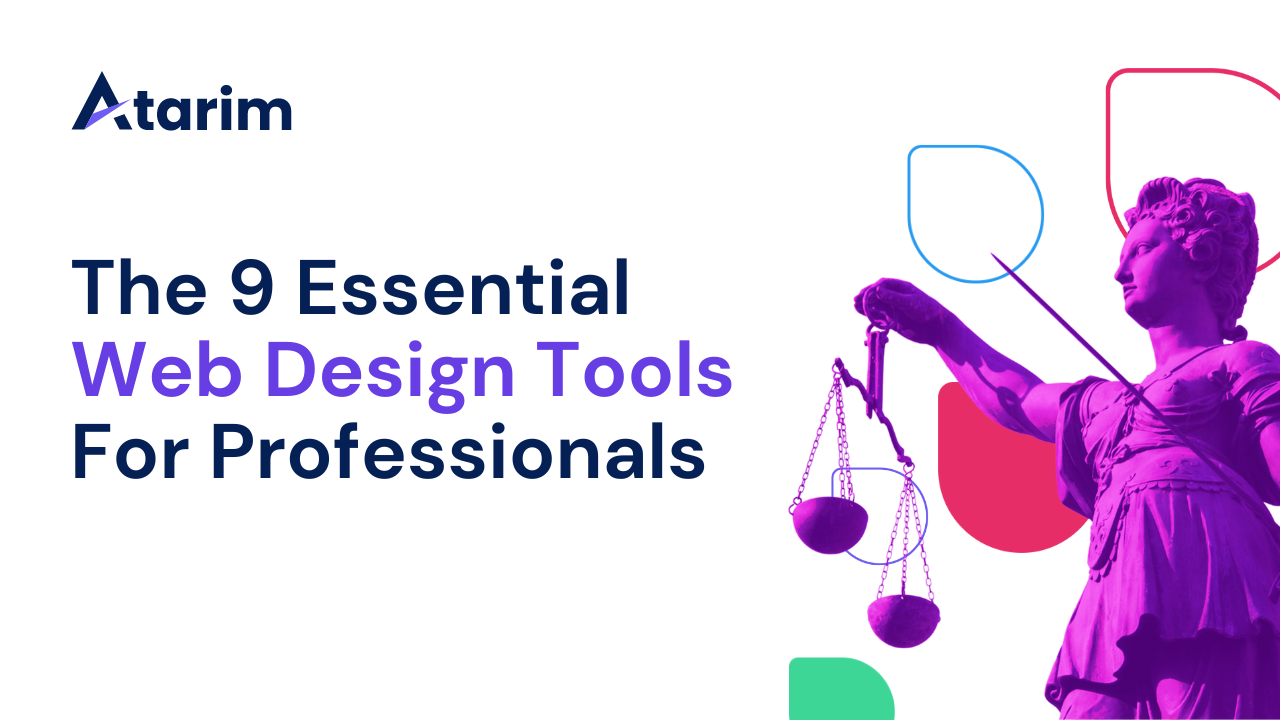In this guide, we share our shortlist of the best web design tools on the market, as well as how we & our community use them to deliver projects faster, better, and with confidence.
Over the past year, we’ve seen significant movement in what designers and developers expect from the tools in their stack – demanding more and more.
Today’s tools are all about collaboration, real-time feedback, and seamless integration between the design stage and development. One example you’ve likely come across that does this is Figma’s dev mode.
So, without further ado, let’s dive in – here are the tools & software trusted by seasoned professionals at industry-leading companies to deliver their best work:
Types of Web Design Tools (Categories)
We’ve broken up our shortlist of tools into types (categories) so it’s easier to follow since there are multiple tools per category/type, but most will only need one for each use-case:
UI/UX Design Tools: Think of where you go to create your design system, map out flows before you bring design work to the development stage (wireframing, prototyping and testing layouts).
Collaborative Tools: Collaboration is now a fundamental part of how design teams work in today’s digital landscape, with teams often spread across different locations and time zones. Good collaboration tools such as Atarim have become an indispensable part of the way design teams communicate and manage the workflow efficiently.
Typically, these tools provide a platform for designers, developers, and stakeholders to come together to review, comment, and approve designs either in real-time, or asynchronously.
Graphic Design Tools: These are the design tools that are essential for creating all of the visual elements of a website, giving it its visual appeal and unique identity. From logos and icons to illustrations and other graphical elements, a good graphic design tool should allow designers to create depth and context to a design, and provide a versatile range of functions.
Code Editors: Following the graphical design, it’s time to turn beauty into functionality. These tools provide developers with an environment in which they can write, edit, and test code. Good tools include user-friendly and customizable interfaces, extensive plugin ecosystems, and a full range of integrated development features.
UI/UX Design Tools
Figma

Figma remains a popular choice of design tool for UI and UX, largely due to its cloud-based, collaborative approach. This means that design teams can work together on a single design, regardless of where they’re located. Collaboration in real-time is seamless, and can be used to support the design process from the initial ideation all the way through to prototyping, and is ideal for getting feedback on design ideas.
The collaborative way in which Figma allows teams to work simultaneously on design ideas helps to speed up the feedback and iteration process, and for designers who are working as part of a team, Figma remains an ideal tool for streamlining the design process and increasing overall productivity.
Key Features
- Real-time collaboration
- Vector networks for flexible design
- Comprehensive plugin ecosystem
- Built-in prototyping capabilities
Pricing
A free tier is available, which is ideal for a limited number of projects. Beyond this, you’ll need a professional plan, which starts at $12 per editor, per month.
Adobe XD

Adobe XD has been around for nearly 7 years already, and has continued to grow to become one of the most powerful tools for creating UX for websites. One of the great features of Adobe XD is that it integrates seamlessly with the entire Adobe Creative Cloud toolbox, which means you can switch easily between different formats, tools, and disciplines.
With a repeat grid function that lets designers quickly and easily duplicate design elements, and an auto-animate feature that helps bring prototypes to life, XD is a hugely efficient design-to-prototype tool. This is especially suitable for designers who are particularly focused on adding interaction and motion into the UX/UI.
Key Features
- Co-editing for real-time collaboration
- Voice prototyping
- Adobe Creative Cloud integration
- Responsive resizing
Pricing
A free starter plan is available, with paid plans starting from $9.99 per month, per user.
Sketch

Sketch has been a primary design tool of choice for many designers in the digital world, with a focus on screen design. It provides a vector-based approach that is ideal for high-fidelity user interfaces or prototypes.
With a unique symbol system and reusable elements, it’s an extremely efficient tool, especially for more complex interfaces where it’s essential to make sure elements are consistent. With a focus on simplicity and efficiency, it’s the preferred tool for designers who are focused on clean, scalable designs.
Key Features
- Vector editing
- Non-destructive editing
- Extensive plugin library
- Symbols for reusable components
Pricing
Sketch is available at $9 per user, per month, billed annually.
Collaborative Tools
Atarim

Atarim is the visual collaboration platform trusted by industry-leading teams to collect, triage, and action tasks on design projects. Like sticky notes on a webpage, your product UI, or ad creative, but better – ship your best work, together.
Over 80% of time on any design project is wasted in meetings or playing email ping pong. Teams use Atarim to buy back this time, freedom, and sanity.
Sidenote: Hey, that’s us 👋 (and yes, we use Atarim as a part of our own process, of course)
Key Features
- Visual feedback system
- Task automation
- Agency dashboard for managing multiple projects
- Integration with popular project management tools
Pricing
A Free Forever plan is available that supports 1 user and 3 active projects. Premium plans start from just $20 per month.
Graphic Design Tools
Canva

Canva has opened up the opportunity for great graphic design to almost everyone, but despite this it’s still packed with tools. Offering a simple, intuitive, drag-and-drop interface with a huge library of templates, Canva makes professional graphic design readily available.
But it’s not limited to just templates, with a range of tools that make it easy to create a wide range of visual content quickly, from social media graphics to presentations, and ads to page headers. Ideally suited to non-designers and professionals alike, it offers a slick interface that converts plans to polished designs without the need for extensive design skills or a lengthy training period.
Key Features
- User-friendly interface
- Extensive template library
- Drag-and-drop design
- Wide range of stock images and fonts
Pricing
There is a free basic plan, with pro plans starting at $12.99 per month.
Adobe Illustrator

When it comes to vector graphics editing, Adobe Illustrator sets the gold standard, offering unrivaled tools for creating logos, icons, drawings, typography, and complex vector illustrations. It’s a hugely versatile tool, offering enormous versatility and an unmatched range of tools for creating designs that are unmatched. It’s no surprise that, 40 years after its original launch in 1983, Adobe Illustrator is the favorite design tool of choice by professional graphic designers and illustrators.
With its comprehensive set of features and tremendous flexibility, it’s an indispensable tool for professional graphic design work, and the perfect choice when it comes to detailed vector artwork and designs.
Key Features
- Sophisticated vector drawing tools
- Gradient meshes
- Advanced color controls
- Brush customization
Pricing
Plans start at $22.99/month.
Code Editors
Visual Studio Code

Visual Studio Code is a completely free tool that successfully combines the simplicity of a code editor with the power of a sophisticated Integrated Development Environment (IDE). It offers support for a huge range of programming languages and frameworks, and is highly customizable, allowing developers to adapt the interface and functionality to suit their own needs and preferences.
VS Code has a reputation for efficiency and flexibility and is one of the most popular choices for developers looking for a stable, robust, and versatile coding environment that’s ideal for both front-end and back-end development.
Key Features
- IntelliSense for smart completions based on variable types
- Function definitions & imported modules
- Built-in Git commands
- Vast ecosystem of extensions
Pricing
Completely free.
Sublime Text

With the popular coding editor Atom being sunsetted, many developers who don’t opt for VS Code are instead choosing Sublime Text, a sophisticated text editor for code and markup. This is largely due to its reputation for both speed and efficiency, offering a slick user interface that packs a wealth of features.
Sublime Text is highly customizable, and supports a wide range of programming languages, which makes it ideal for developers working on either web projects, apps, or software development. It’s able to handle large files efficiently, and has an extensive plugin ecosystem. With a recently refreshed UI, and the addition of context-aware autocomplete, syntax definitions, optional GPU rendering, support for Typescript, JSX and TSX, and Regex find-and-replace, it’s a powerful tool that should be considered seriously by any developer in 2024.
Key Features
- “Goto Anything” for quick navigation to files, symbols, or lines
- “Multiple Selections” allowing users to make changes in multiple places simultaneously
- Customizable key bindings, menus, and snippets
- A powerful API and package ecosystem
Pricing
Free to download and use for evaluation purposes. If you continue to use it, you must purchase a license, which costs $99 and includes 3 years of updates.
After Action Report – Handpick Your Ideal Web Design Toolkit
We hope you found this compilation of the very best web design tools out there helpful.
In short, the main ones in our stack are:
- Atarim: yes, our own product, we built it for internal use first after all! Used to collaborate on anything once it’s out of Figma (i.e. real UI/not mockups/design specifications).
- Figma: for all complex design work including product design of Atarim.
- Canva: for simpler graphics on social, etc.
Choosing the right tools is about more than just following trends and trying to keep up with the hype – you need systems and solutions that streamline your workflow.
We recommend keeping things lean and simple. Unless there are good reasons to do it differently, you really only need one solution like Figma for prototyping and designing, a platform to collaborate on your designs during and after dev, Atarim, and something for your marketing and growth team to whip up simpler graphics for social media.
With Atarim, you can use simple point-and-click collaboration to enable clients to point at what they’re referring to on any live web page, and immediately leave feedback, say what needs to be changed, and so much more.
If you want to receive feedback that makes sense, make it easier to collaborate with clients, and finish projects in days instead of weeks, sign up to Atarim today – with paid plans from just $20 per month.
- Integrated into the leading visual collaboration platform trusted by 13,000+ agencies (web dev, design, and beyond) worldwide.
- Supporting project delivery for 1,200,000+ of their clients and stakeholders.
- Deliver projects in days instead of weeks.



